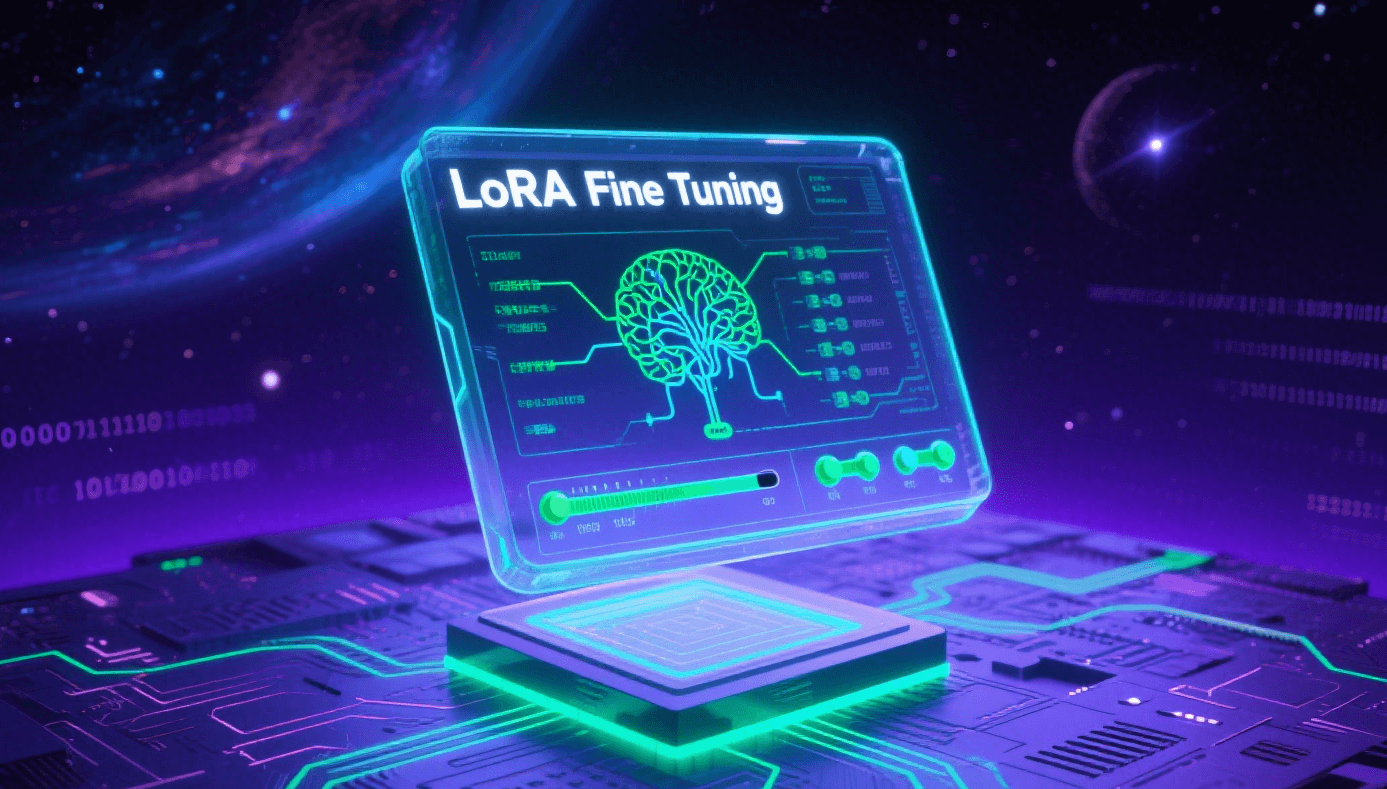What is LoRA?
LoRA (Low-Rank Adaptation) is a parameter-efficient fine-tuning technique designed to adapt large pre-trained language models (LLMs) such as GPT-3 or BERT to specific tasks or domains without updating the entire model. Instead of modifying all model weights, LoRA trains small rank-decomposed matrices (adapters) that are added to specific layers of the pre-trained model. This approach drastically reduces the number of trainable parameters while maintaining comparable performance to full fine-tuning.
What is LoRA fine tuning?
LoRA fine tuning fixes the original parameters of the pre-trained model and only adds trainable low-rank decomposed matrices to the weight matrix of each layer. Specifically, for a weight matrix W of a certain layer with an original dimension of d×k, LoRA decomposes it into two low-rank matrices A (dimension d×r) and B (dimension r×k), where r≪min(d,k). During fine-tuning, the model output is the superposition of the product of the original weight and the low-rank matrix.
Benefits of Using LoRA Fine Tuning
Parameter Efficiency
LoRA significantly cuts down the number of parameters that must be updated during fine-tuning. In a standard transformer-based LLM, the majority of parameters are in large weight matrices. LoRA updates these matrices by adding a low-rank perturbation, meaning only a small fraction of parameters (those in the adapters) need to be adjusted. This not only saves time but also reduces the complexity of the fine – tuning process.
Reduced Memory and Compute Requirements
Since only the adapter parameters (the added low-rank matrices) need to be stored in GPU memory for gradient computation, fine-tuning with LoRA can be carried out on hardware with limited memory. This efficiency also leads to faster training iterations, as there is less data to process and store during the training phase.
Preservation of Pre-trained Knowledge
By freezing the base model’s parameters, LoRA ensures that the broad general knowledge acquired during large-scale pre-training is maintained. The adapters then specialize the model for downstream tasks, preventing catastrophic forgetting, where the model loses its previously learned knowledge while adapting to new tasks.
When to Choose LoRA or Full Fine-Tuning?
Choose Full Fine-Tuning When
- Highest accuracy is paramount, especially in complex domains like programming and mathematics. It generally outperforms LoRA in terms of accuracy and sample efficiency in such scenarios.
- Dealing with large datasets for continued pretraining (CPT). It excels in this context compared to LoRA.
- You have sufficient computing resources, as it optimizes all model parameters, which requires more resources.
Choose LoRA When
- Preserving model generalizability is crucial. It mitigates the “forgetting” of the source domain better than full fine-tuning, making the model more versatile across tasks outside the target domain.
- Handling instruction fine-tuning (IFT) with smaller, task-specific datasets. It performs better than full fine-tuning in such scenarios.
- Adapting the model to multiple related tasks (e.g., summarizing text and translating languages), as its regularization properties help prevent overfitting.
- Resource constraints are a concern, as it is a parameter-efficient method that trains only low-rank perturbations to selected weight matrices, requiring fewer computing resources.
Step-by-Step Guide to Fine Tuning with LoRA
- Select the Base Model: Choose a pre-trained large language model that suits your task. Popular models include GPT-2, BERT, and T5.
- Install the Required Libraries: You will need libraries such as Hugging Face’s PEFT (Parameter-Efficient Fine-Tuning) library, which provides support for LoRA. Install it using pip install peft.
- Load the Base Model and Tokenizer: Use the appropriate functions from the Hugging Face Transformers library to load the pre-trained model and its corresponding tokenizer.
- Configure the LoRA Adapter: Define the LoRA configuration parameters such as the rank (r), lora_alpha, lora_dropout, and bias settings. For example, lora_config = LoraConfig(r = 8, lora_alpha = 16, lora_dropout = 0.05, bias = ‘none’, task_type = “seq_2_seq_lm”).
- Attach the LoRA Adapter to the Model: Use the PEFT library to attach the configured LoRA adapter to the selected layers of the base model.
- Prepare the Training Dataset: Format your dataset in the appropriate format for the model. This may involve tokenizing the text, splitting it into training and validation sets, etc.
- Set Up the Training Loop: Define the training parameters such as the learning rate, batch size, and number of epochs. Use an optimizer like AdamW to update the LoRA weights.
- Train the Model: Start the training loop, where the model will learn from the training dataset by adjusting only the LoRA weights.
- Evaluate the Model: After training, evaluate the fine-tuned model on a validation or test dataset to measure its performance.
Overcoming the Illusion of Equivalence
It’s easy to assume LoRA and full fine-tuning are interchangeable, but performance comparisons show this isn’t true. To choose wisely, test both approaches across different models, datasets, and tasks. For example: With limited resources, LoRA may be preferable even if it lags slightly in some metrics. For top performance with ample resources, full fine-tuning is often better.
Case Studies in Industry
Natural Language Processing
In the field of natural language processing, LoRA has been used to fine – tune models for various tasks such as sentiment analysis, question-answering systems, and text generation. For example, a company might use LoRA to fine-tune a pre-trained language model to better analyze customer reviews for sentiment. By using LoRA, they can adapt the model to their specific domain (e.g., a particular industry’s jargon) without having to retrain the entire model from scratch, saving time and resources.
Image Recognition
In image recognition, LoRA can be applied to fine-tune convolutional neural networks (CNNs). For instance, a security company may use LoRA to fine-tune a pre-trained CNN to recognize specific types of objects in surveillance footage more accurately. The low-rank adaptation allows for quick adaptation to the unique characteristics of the surveillance data, such as different lighting conditions and camera angles.
Future of LoRA in Machine Learning
LoRA is set to become a cornerstone of AI model optimization. As demand grows for efficient, cost-effective fine-tuning, we’ll see:
- Improvements in LoRA’s efficiency (e.g., smaller adapters with better performance).
- Wider integration into ML frameworks (e.g., Hugging Face, PyTorch), making it accessible to more developers.
- Expansion beyond NLP to fields like computer vision and robotics, where parameter efficiency is critical.
LoRA isn’t just a technique—it’s a shift toward smarter, more accessible AI model adaptation. By balancing performance and efficiency, it’s revolutionizing how we optimize large models for real-world tasks.

